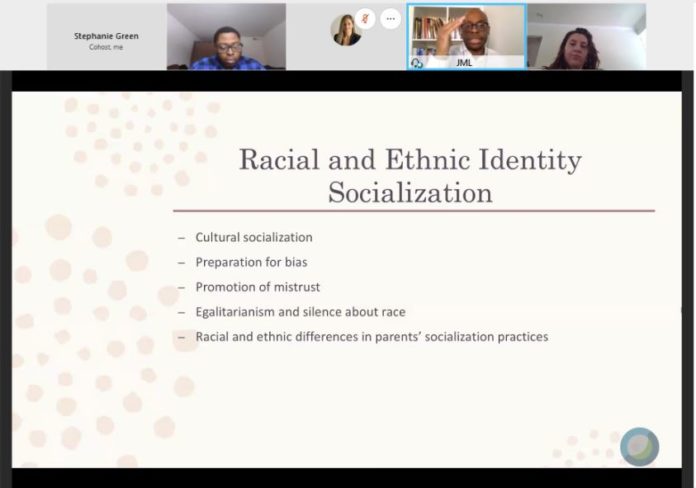
Rowan University students and faculty joined together in discussion of racial and ethnic identity development and its impact on mental health during a virtual education session hosted by U Good F.A.M. on Thursday, Feb. 18.
U Good F.A.M. – a network created to address the mental health issues and needs of racially and ethnically diverse students on campus – welcomed guest speaker Jonathan Lassiter, Ph.D., polymath, assistant professor of psychology at Rowan and co-editor of the book “Black LGBT Health in the United States: The Intersection of Race, Gender and Sexual Orientation.”
“We all have racial and ethnic identity whether we realize it or not,” Lassiter said. “The ways in which we think about our racial and ethnic identity are pervasive, meaning it influences every part of our lives.”
Lassiter explained the socialization process, as well as the different types of racial and ethnic identity socialization. While explaining its impact on the ways in which we interact with the world, Lassiter stated that parents are the primary socialization agent.
Parents can be involved in cultural socialization, in which they share information — such as important holidays or ancestors — that allows their children to understand and take pride in their culture and heritage. According to Lassiter, parents can also be involved in preparing their children for bias by explaining that they may be treated differently due to their race or ethnicity.
This preparation enables children to learn ways in which they can better handle these difficult situations. Some parents, on the other hand, may also promote mistrust, in which they tell their children not to trust specific types of people.
Preparing children for bias also has health outcomes, according to Lassiter. He stated that by explaining to children that they may be treated differently — as his father did to him — they develop better coping strategies when experiencing bias in the real world.
“My father told me, ‘Slim, when you get out there in the world, you’re gonna have to work twice as hard for half of the recognition,’” Lassiter said.
Lassiter went on to explain another type of socialization — the egalitarian approach. Equating this approach with color blindness, he described egalitarianism as the equal treatment of all people; where there is no color, there are only being human beings.
“It says to treat people like human beings — which is true — but it misses the strengths and uniqueness that comes along with particular racial and ethnic backgrounds,” Lassiter said.
According to Lassiter, the type of socialization that a child receives will impact both their academic achievements and mental health. Cultural socialization, specifically, has been associated with achieving higher GPAs — which psychologists theorize is due to higher levels of self-esteem — while the egalitarian approach has led to lower GPAs.
“If they get all this cultural socialization and develop this pride about themselves, then that carries over into other domains,” Lassiter said.
In addition to higher GPAs, cultural socialization is also associated with lower levels of depression and anxiety, as well as fewer behavioral problems.
Lassiter concluded his presentation by discussing what can be done to address racial and ethnic identity on college campuses, focusing on the need for diverse curriculums.
He went on to discuss how important the role of the university’s curriculum can play in cultural socialization and, therefore, student mental health, revealing that students are often given a white-washed curriculum that fails in allowing them to see themselves as integral part of the learning experience. This, in turn, leads to less engagement from the students, resulting in lower GPAs.
He continued in saying that there is a need for students of certain racial or ethnic groups to have their own spaces, where they can become immersed in their culture and gain cultural socialization that will lead to better in-class performance. Finally, he emphasized the need for counselors that reflect the student body.
“Psychotherapy research shows that people typically want to see counselors that they believe will understand them, and oftentimes, people are making those beliefs off of race and ethnicity,” Lassiter said. “Do our on-campus resources represent our students? Do they look like our student population?”
While these were only a few of his suggestions, Lassiter emphasized his hope that other students would also offer their input, given that different students will require different solutions to satisfy their needs.
He concluded his core lecture by explaining that while discussing racial issues is often trendy, it loses momentum because “there aren’t enough dollars flowing in.” Because of this, there must be a focus on how the university’s budget allocation serves the needs of different racial and ethnic groups that its students represent.
For comments/questions about this story, email features@thewhitonline.com or tweet @TheWhitOnline.





